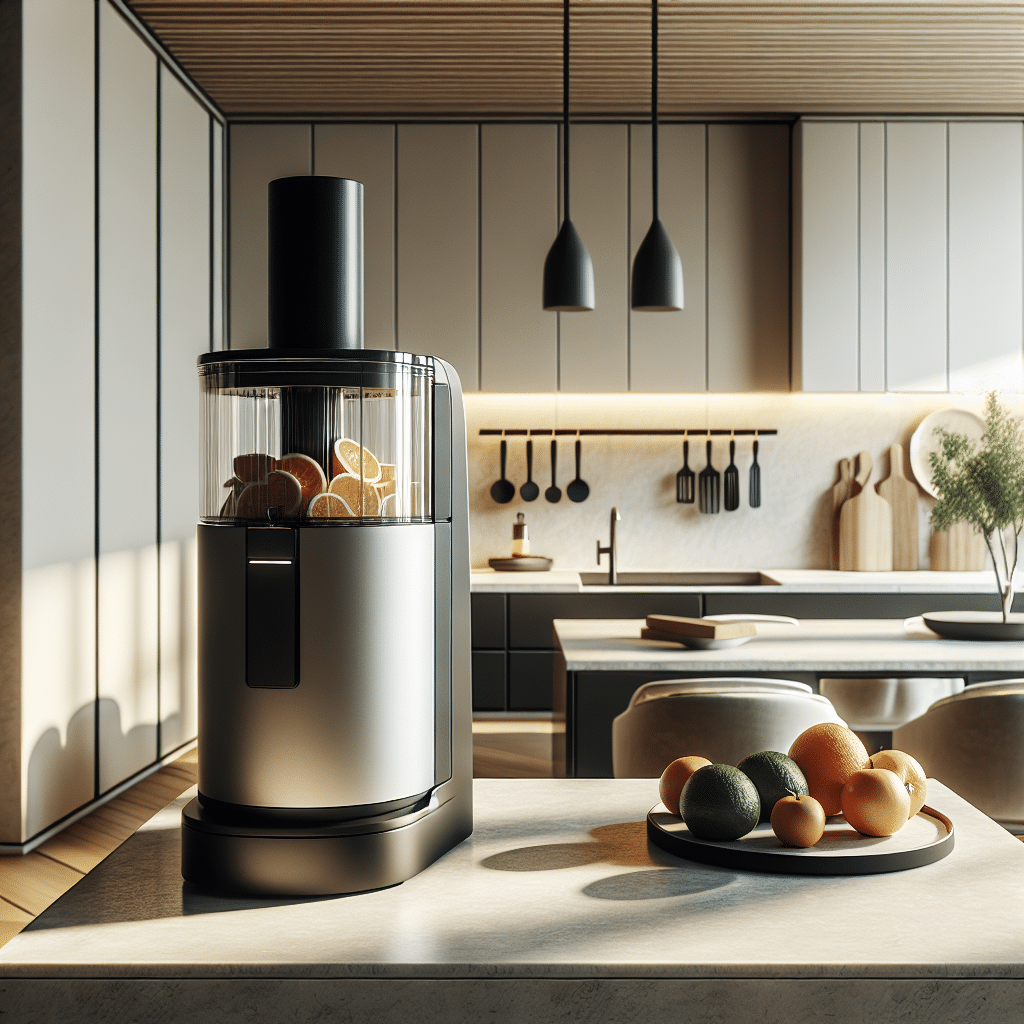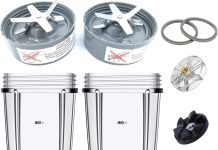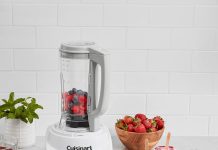If you’re a juice enthusiast but often find yourself with limited kitchen counter space, vertical juicers might just be your saving grace. These space-efficient juicers offer a practical solution for cramped kitchens, allowing you to enjoy your favorite freshly squeezed juices without compromising on counter space. With their sleek and compact design, these vertical juicers not only save you valuable kitchen real estate but also provide an efficient and convenient way to incorporate healthy juicing habits into your daily routine. Say goodbye to cluttered countertops and hello to space-efficient juicing with vertical juicers.
Review contents
Overview
What are vertical juicers?
Vertical juicers, also known as upright juicers, are a type of juicer that is designed to maximize space efficiency while providing efficient juice extraction. Unlike traditional horizontal juicers, vertical juicers have a tall and narrow design that takes up minimal counter space. These juicers are specifically designed to be compact and versatile, making them a great choice for individuals who have limited kitchen space.
Benefits of vertical juicers
There are several benefits to using a vertical juicer for space-efficient juicing. Firstly, the compact footprint of these juicers means that they take up significantly less counter space compared to other types of juicers. This is particularly advantageous for those who have smaller kitchens or limited workspace.
Secondly, vertical juicers are designed to efficiently juice a wide range of ingredients, including leafy greens, resulting in high juice yield. They also have the ability to make nut milk and sorbets, providing versatility in their functionality.
Lastly, vertical juicers are known for their ease of use and cleaning. With a simple and intuitive design, they are user-friendly and can be quickly disassembled and cleaned after each use. This makes them a convenient option for individuals who are looking for hassle-free juicing.
Why choose a vertical juicer for space-efficient juicing
Choosing a vertical juicer for space-efficient juicing is a smart choice for several reasons. Firstly, the compact footprint of vertical juicers allows you to save valuable counter space in your kitchen. This is especially important if you have a small kitchen or limited workspace.
Secondly, the tall and narrow design of vertical juicers makes them perfect for fitting into tight spaces. Their sleek and slim profile allows them to be easily stored in cabinets or on shelves when not in use.
Lastly, vertical juicers are specifically designed to efficiently extract juice from a variety of ingredients, including leafy greens. Their vertical auger and slow juicing process ensure maximum juice yield, making them ideal for those who want to get the most out of their produce.
Design and Functionality
Vertical juicer design
Vertical juicers are characterized by their tall and narrow design. Unlike horizontal juicers, which have a wide and horizontal layout, vertical juicers have a compact and space-saving profile. They typically have a cylindrical or rectangular shape, with the juice collection container located at the base and the feeding chute at the top.
The design of vertical juicers is sleek and modern, making them a stylish addition to any kitchen. They are available in a variety of colors and finishes, allowing you to choose a juicer that matches your kitchen decor.
How vertical juicers work
Vertical juicers work by using a vertical auger to extract juice from fruits and vegetables. The auger is typically made of a durable and food-grade material, such as stainless steel or BPA-free plastic. It rotates at a slow speed, using gentle pressure to crush and squeeze the produce, extracting the juice while leaving behind the pulp.
The slow juicing process of vertical juicers helps to preserve the nutrient content and flavor of the juice, resulting in high-quality and nutritious beverages.
Key components and features
Vertical juicers consist of several key components that work together to efficiently extract juice. These components include:
-
Feeding chute: The feeding chute is the opening at the top of the juicer where you insert the fruits and vegetables. It is typically wide enough to accommodate whole pieces of produce, reducing the need for pre-cutting.
-
Auger: The auger is the rotating component of the juicer that crushes and squeezes the produce to extract the juice. It is usually made of a durable material and has a spiral shape.
-
Juice collection container: The juice collection container is where the extracted juice is collected. It is located at the base of the juicer and is typically detachable for easy pouring and cleaning.
-
Pulp container: The pulp container collects the leftover pulp from the juicing process. It is also located at the base of the juicer and is often detachable for easy disposal of the pulp.
-
Motor: The motor powers the rotating auger and controls the speed of the juicing process. It is important to choose a juicer with a powerful motor for efficient juicing.
Vertical juicers may also include additional features such as variable speed settings, pulp control options, and safety features like overload protection and automatic shut-off.
Space Efficiency
Compact footprint
One of the major advantages of vertical juicers is their compact footprint. Unlike larger and bulkier horizontal juicers, vertical juicers have a smaller overall size, occupying less counter space. This is especially beneficial for individuals who have limited kitchen space or prefer to keep their countertop clear of clutter.
The compact footprint of vertical juicers allows you to easily store them in cabinets, on shelves, or in other tight spaces when not in use. This helps to keep your kitchen organized and free from unnecessary clutter, while still allowing you to enjoy the benefits of juicing.
Tall and narrow design
In addition to their compact footprint, the tall and narrow design of vertical juicers further enhances their space efficiency. The vertical orientation of these juicers maximizes the use of vertical space, making them ideal for kitchens with limited countertop or storage space.
The slim profile of vertical juicers allows them to fit into narrow spaces, such as between other kitchen appliances or in tight corners. This makes it easy to find a suitable spot for your juicer, even in kitchens with limited space.
Minimal counter space required
Due to their compact footprint and tall and narrow design, vertical juicers require minimal counter space. Unlike traditional juicers that can take up a significant amount of space on your countertop, vertical juicers can be placed in compact and tight areas without sacrificing performance.
The minimal counter space required by vertical juicers allows you to have more room for other kitchen tasks and appliances. You can easily juice your favorite fruits and vegetables without having to rearrange or declutter your countertop.
Versatility
Wide range of ingredients
Vertical juicers are capable of juicing a wide range of ingredients, making them versatile appliances for your kitchen. Whether you want to juice fruits, vegetables, or a combination of both, a vertical juicer can handle it all.
From hard fruits like apples and carrots to soft fruits like berries and oranges, a vertical juicer can effectively extract juice from a variety of produce. This versatility allows you to experiment with different flavor combinations and enjoy a diverse range of juices.
Efficient juicing of leafy greens
One of the notable features of vertical juicers is their ability to efficiently juice leafy greens. Leafy greens, such as kale, spinach, and wheatgrass, are often a challenge to juice due to their fibrous nature. However, vertical juicers are specifically designed to handle these ingredients with ease.
The slow juicing process of vertical juicers ensures that the leafy greens are thoroughly crushed and squeezed, extracting the maximum amount of juice. This results in high juice yield and allows you to enjoy the nutritional benefits of leafy greens in your juices.
Ability to make nut milk and sorbets
In addition to juicing fruits and vegetables, vertical juicers also have the ability to make nut milk and sorbets. By simply swapping out the juicing strainer for a different attachment, you can transform your juicer into a versatile kitchen tool.
Making nut milk with a vertical juicer is a simple and convenient process. Just soak your choice of nuts or seeds, blend them with water, and pass the mixture through the juicer. The juicer will separate the nut milk from the pulp, giving you a smooth and creamy dairy-free alternative.
Similarly, with the sorbet attachment, you can turn frozen fruits into a delicious and healthy frozen treat. The vertical juicer effortlessly processes the frozen fruit, resulting in a smooth and creamy sorbet-like consistency.
Juicing Performance
Efficiency and yield
When it comes to juicing performance, vertical juicers excel in both efficiency and yield. The slow and gentle juicing process of these juicers ensures that the maximum amount of juice is extracted from the produce, resulting in high juice yield.
The vertical auger of the juicer works by slowly and steadily crushing the fruits and vegetables, releasing their juice. The juice is then separated from the pulp, which is collected in a separate container. This efficient juicing process ensures that you get the most out of each ingredient, reducing waste and maximizing the nutritional content of your juices.
Quality of juice
The quality of the juice produced by a vertical juicer is another important factor to consider. Due to their slow juicing process, these juicers help to preserve the natural flavors and nutrients of the fruits and vegetables.
Unlike high-speed centrifugal juicers that generate heat and introduce oxygen into the juice, vertical juicers operate at a low speed, minimizing oxidation. This helps to preserve the enzymes, vitamins, and minerals in the juice, resulting in a fresher and more nutrient-dense beverage.
The slow juicing process also reduces foaming and separation in the juice, resulting in a smoother and more enjoyable drinking experience. The juice produced by a vertical juicer is often described as being rich in flavor and having a vibrant color.
Ease of use and cleaning
Vertical juicers are designed to be user-friendly and easy to clean. They typically have a simple and intuitive design, making them suitable for both beginner and experienced juicers.
The feeding chute of a vertical juicer is usually wide enough to accommodate whole pieces of produce, minimizing the need for pre-cutting. This saves you time and effort in the juicing process.
Cleaning a vertical juicer is also a breeze. Most models come with dishwasher-safe parts that can be easily disassembled for cleaning. The components, such as the auger, juice collection container, and pulp container, can be rinsed under running water or placed in the dishwasher for a thorough clean.
Noise and Power
Quiet operation
Noise level is an important consideration, especially for those who prefer a quieter juicing experience. Vertical juicers are known for their quiet operation, making them suitable for use in apartments, shared living spaces, or early morning juicing sessions.
Unlike high-speed centrifugal juicers that can be loud and noisy, vertical juicers operate at a low speed, resulting in reduced noise. The slow rotation of the auger minimizes vibrations and ensures a peaceful and silent juicing experience.
Motor power and speed options
The motor power of a vertical juicer is an important factor to consider, as it determines the efficiency and performance of the juicer. Higher motor power generally means faster juicing and better extraction.
Vertical juicers typically have motors with a power range of 150 to 250 watts. While lower-powered models may require a bit more time for juicing harder produce, they still deliver satisfactory results. Higher-powered models, on the other hand, offer faster juicing and can handle tougher ingredients with ease.
Some vertical juicers also offer multiple speed options, allowing you to customize the juicing process for different types of produce. This flexibility in speed settings ensures optimal extraction and allows you to achieve the desired consistency and texture in your juice.
Variable speed settings
Certain vertical juicers come with variable speed settings, which provide even more control over the juicing process. With variable speed options, you can adjust the juicer’s speed based on the type and texture of the produce you are juicing.
Slower speeds are ideal for juicing soft fruits and leafy greens, as they allow for maximum extraction without damaging the delicate fibers. Higher speeds, on the other hand, are suitable for juicing harder fruits and vegetables, ensuring efficient juicing.
Variable speed settings give you the flexibility to customize your juicing experience and achieve the desired results for different types of produce.
Durability and Build Quality
High-quality materials
When it comes to durability and build quality, vertical juicers are often made with high-quality materials that ensure long-lasting performance. The components of these juicers, such as the auger, juicing strainer, and juice collection container, are typically made from food-grade materials that are durable and resistant to wear and tear.
Stainless steel and BPA-free plastic are commonly used in the construction of vertical juicers. These materials are known for their strength, corrosion resistance, and easy cleaning, making them ideal for juicing appliances.
Additionally, vertical juicers often come with reinforced internal components, such as sturdy motor bases and robust juicing chambers, further enhancing their durability and ensuring that they can withstand regular use.
Long-lasting performance
Vertical juicers are designed to provide long-lasting performance, allowing you to enjoy years of efficient juicing. The durable construction and high-quality materials used in these juicers contribute to their longevity.
The slow juicing process of vertical juicers also helps to prolong the lifespan of the appliance. By operating at a low speed, the motor is subjected to less stress and strain, reducing the risk of overheating and premature wear.
Regular maintenance and proper cleaning of the juicer, as outlined in the user manual, can also contribute to its long-lasting performance. It is important to follow the manufacturer’s guidelines for cleaning, as improper cleaning methods can damage the juicer and affect its performance.
Warranty considerations
When purchasing a vertical juicer, it is important to consider the warranty provided by the manufacturer. A warranty offers assurance and protection in case of any defects or malfunctions that may occur within a certain period of time.
Different juicer brands offer varying warranty coverage, ranging from six months to several years. It is recommended to choose a juicer with a warranty that provides sufficient coverage for your needs.
Additionally, it is important to review the warranty terms and conditions to understand the coverage and any restrictions or exclusions that may apply. This will help you make an informed decision and ensure that you are protected in case of any issues with the juicer.
Additional Features
Pulp control options
Vertical juicers often come with pulp control options that allow you to customize the pulpiness of your juice. These options typically include settings for adjusting the amount of pulp in the juice, ranging from low to high.
For those who prefer smoother juice with minimal pulp, setting the juicer to low pulp is ideal. On the other hand, if you enjoy a thicker and more substantial juice with some pulp, setting the juicer to high pulp will deliver the desired consistency.
Pulp control options give you the versatility to tailor your juice to your personal preferences, ensuring a satisfying and enjoyable juicing experience.
Juice collection containers
Vertical juicers usually come with juice collection containers that are detachable for easy pouring and cleaning. These containers are designed to hold a sufficient amount of juice, allowing you to juice continuously without the need for frequent emptying.
The capacity of the juice collection container varies between models, with larger containers being able to hold more juice. It is important to consider your juicing needs and the amount of juice you typically consume when choosing a juicer with the appropriate container capacity.
Some juicers may also come with additional containers, such as separate containers for foam and seed separation. These containers offer added convenience and make it easier to customize your juicing process.
Safety features and certifications
Safety is an important consideration when using any kitchen appliance, including juicers. Vertical juicers often come with safety features that ensure safe and smooth operation.
Common safety features of vertical juicers include overload protection, which automatically shuts off the juicer if the motor becomes overloaded or overheated. This prevents damage to the motor and ensures the longevity of the appliance.
Additionally, vertical juicers may also be certified by recognized safety organizations, such as UL (Underwriters Laboratories) or ETL (Intertek). These certifications indicate that the juicer has undergone rigorous testing and meets the safety standards set by these organizations.
Before purchasing a vertical juicer, it is recommended to review the safety features and certifications to ensure that you are choosing a safe and reliable product.
Price Range and Affordability
Variety of price points
Vertical juicers come in a variety of price points to suit different budgets and preferences. The price of a vertical juicer can vary depending on factors such as brand reputation, motor power, additional features, and build quality.
Entry-level vertical juicers can start as low as $50 to $100. These models usually have basic features and lower motor power but still offer great value for those who are new to juicing or have a limited budget.
Mid-range vertical juicers typically fall in the $100 to $200 range. They often have more powerful motors, additional features, and improved build quality. These juicers are suitable for individuals who are looking for a balance of performance and affordability.
High-end vertical juicers can range from $200 to $500 or more. These premium models usually boast powerful motors, advanced features, and superior build quality. They are designed for those who prioritize durability, efficiency, and high-performance juicing.
Factors influencing the price
Several factors can influence the price of a vertical juicer. These factors include:
-
Brand reputation: Established and reputable brands tend to command higher prices due to their brand value and customer trust.
-
Motor power: Juicers with higher motor power often come with a higher price tag, as they offer more efficient juicing and better performance.
-
Additional features: Juicers with additional features, such as variable speed settings, pulp control options, and safety features, are generally priced higher than basic models.
-
Build quality: Juicers made with high-quality materials and components are often priced higher due to their durability and long-lasting performance.
-
Warranty coverage: Juicers that come with longer warranty coverage may be priced higher to account for the additional support and protection offered to the consumer.
Value for money
When considering the price of a vertical juicer, it is important to evaluate the value for money that it offers. A reasonably priced juicer that meets your specific needs and preferences, and is built to last, can provide great value and a positive juicing experience.
To determine the value for money, consider factors such as the durability of the juicer, the efficiency and yield it provides, the quality of the juice produced, and the additional features it offers. A juicer that ticks all the boxes and provides a long-lasting and enjoyable juicing experience is worth the investment.
Final Thoughts
Conclusion on vertical juicers for space-efficient juicing
Vertical juicers are an excellent choice for individuals who prioritize space efficiency in their juicing routine. These juicers offer a compact footprint, tall and narrow design, and minimal counter space required, making them a great option for kitchens with limited space.
Not only are vertical juicers space-efficient, but they also excel in versatility, juicing performance, noise and power, durability, and additional features. With their ability to efficiently juice a wide range of ingredients, including leafy greens, and their capacity to make nut milk and sorbets, vertical juicers provide a versatile juicing experience.
Vertical juicers are designed to provide high juice yield, quality juice, ease of use and cleaning, and quiet operation. Their durability and build quality ensure long-lasting performance, and optional features such as pulp control options and certifications add further convenience and peace of mind.
Considerations before purchasing
Before purchasing a vertical juicer, it is important to consider your specific needs and preferences. Some factors to consider include the amount of counter space available, the types of ingredients you plan to juice, the desired juicing performance and features, and your budget.
Taking the time to research and compare different models, read customer reviews, and consider expert recommendations can help you make an informed decision and choose the best vertical juicer for your needs.
Tips for maximizing efficiency
To maximize efficiency when using a vertical juicer, consider these tips:
-
Wash and prepare your produce before juicing. Remove any stems, seeds, or tough skins that may affect the juicing process.
-
Alternate between soft and hard produce when juicing. This helps to optimize extraction and prevent clogging.
-
If the juicer becomes clogged, reverse the direction of the auger to clear the blockage. Avoid using excessive force to prevent damage to the juicer.
-
Clean the juicer immediately after each use to prevent pulp from drying and becoming difficult to remove.
-
Experiment with different ingredient combinations to create unique and delicious juices.
By following these tips, you can ensure efficient juicing and maximize the benefits of your vertical juicer. Enjoy the convenience, versatility, and space efficiency that vertical juicers offer in your juicing journey.
































